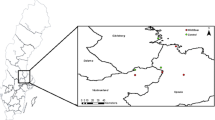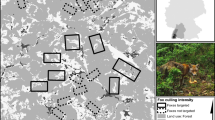Abstract
Predation has received considerable theoretical and empirical support in population regulation. The effect of predators, however, could be achieved in direct (killing) or indirect effects (such as displacement). In this paper, we explored the relationship between Eurasian kestrels Falco tinnunculus and skylarks Alauda arvensis in Mediterranean grasslands. First, we analysed the presence of skylarks in the kestrel diet over 9 years. We also compared a grassland area of experimentally increased kestrel density and a second grassland as control area to evaluate the direct or indirect effect on skylark abundance. We also considered two different habitats, grazed and ungrazed plots. If skylark abundance decreased as the kestrel breeding season progressed in high-density kestrel area compared with the control area, it would suggest a direct effect (predator hypothesis). If skylark abundance remains constant in both areas of contrasting kestrel density, it would suggest that skylarks avoid kestrels (avoidance hypothesis). We found that skylark abundance decreased in the kestrel area from the beginning of kestrel nest-box installation to recent years. The rate of skylark consumption decreased in a 9-year period as kestrel abundance increased, although the total amount skylark consumption did not show a decreasing trend. In addition, skylarks were more abundant in the kestrel-free area than in the kestrel area. Finally, we found that skylark abundance did not change through the kestrel breeding period in relation to grazing. We suggest that an increased breeding density of kestrels during their breeding period may force the skylarks to breed in other areas, which may explain the decline of their abundance.



Similar content being viewed by others
References
Aparicio JM (2000) Differences in the diets of resident and non-resident Kestrels in Spain. Ornis Fenn 77:169–175
Brown JS, Kotler BP, Smith RJ, Wirth WO (1988) The effect of owl predation on the foraging behaviour of heteromyid rodents. Oecologia 76:408–415
Eng RL, Gullionj GW (1962) The predation of goshawks upon ruffed grouse on the Cloquet forest research center, Minnesota. Wilson Bull 74:227–242
Evans DM, Redpath SM, Evans SA, Elston DA, Dennis P (2005) Livestock grazing affects the egg size of an insectivorous passerine. Biol Lett 1:322–325
Evans DM, Redpath SM, Elston DA, Evans SA, Mitchell RJ, Dennis P (2006) To graze or not to graze? Sheep, voles, forestry and nature conservation in the British uplands. J Appl Ecol 43:499–505
Fargallo JA (1999) Efecto del Cernícalo Vulgar Falco tinnunculus sobre la abundancia del Topillo Campesino Microtus arvalis: un caso de manejo de poblaciones naturales. Obra Social y Cultural de la Caja de Ahorros y Monte de Piedad de Segovia, Segovia
Fargallo JA, Blanco G, Sotolargo E (1996) Possible second clutches in a Mediterranean montane population of the Eurasian Kestrel. J Raptor Res 30:70–73
Fargallo JA, Blanco G, Potti J, Viñuela J (2001) Nestbox provisioning in a rural population of Eurasian Kestrels: breeding performance, nest predation and parasitism. Bird Study 48:236–244
Ferguson SH, Bergerud AT, Ferguson R (1988) Predation risk and habitat selection in the persistence of a remmant caribou population. Oecologia 76:236–245
Flowers MA, Graves BM (1997) Juvenile toads avoid chemical cues from snake predators. Anim Behav 53:641–646
Gaibani G, Csermely D, Korpimäki E (2005) Parental care of kestrels living in stable and varying environmental conditions. J Ethol 23:63–67
Geer TA (1968) Effects of nesting sparrowhawks on nesting tits. Condor 80:419–422
González-Esteban J, Vilate I, Gosálbez E (1995) Expansión del área de distribución de Microtus arvalis astrianus Miller 1908 (Rodentia, Arvicolidae) en la Meseta Norte (España). Doñana Acta Vertebrata 22:106–110
Hileman KS, Brodie ED (1994) Survival strategies of the salamander Desmognathus ochrophaelus: interaction of predator avoidance and anti-predator mechanism. Anim Behav 47:1–6
Kennedy M, Shave CR, Spencer HG, Gray RD (1994) Quantifying the effect of predation risk on foraging bullies: no need to assume an IFD. Ecology 75:2220–2226
Korpimäki E (1986) Diet variation, hunting habitat and reproductive output of the Kestrel Falco tinnunculus in the light of the optimal diet theory. Ornis Fenn 63:84–90
Korpimäki E, Norrdahl K (1991) Numerical and functional responses of kestrels, short eared owls, and long-eared owls to vole densities. Ecology 72:814–826
Krebs CJ (2001) Ecology. Addison-Wesley Longman., California
Meese RJ, Fuller MR (1987) Distribution and behaviour of passerines around Peregrine Falco peregrinus eyries in western Greenland. Ibis 131:27–32
Norrdahl K, Korpimäki E (1998) Fear in farmlands: how much does predator avoidance affect bird community structure? J Avian Biol 29:79–85
Pearce-Higgins JW, Grant MC (2006) Relationships between bird abundance and the composition and structure of moorland vegetation. Bird Study 53:112–125
Reif V, Tornberg R, Jungell S, Korpimäki E (2001) Diet variation of common buzzards in Finland supports the alternative prey hypothesis. Ecography 24:267–274
Reif V, Jungell S, Korpimäki E, Tornberg R, Mykra S (2004) Numerical response of common buzzards and predation rate of main and alternative prey under fluctuating food conditions. Ann Zool Fenn 41:599–607
Stephens DW, Krebs JR (1986) Foraging theory. Princeton University Press, Princeton, NJ
Suárez F, Garza V, Morales MB (2003) The role of extensive cereal crops, dry pasture and shrub-steppe in determining skylark Alauda arvensis densities in the Iberian peninsula. Agric Ecosyst Environ 95:551–557
Suhonen J (1993) Predation risk influences the use of foraging sites by tits. Ecology 74:1197–1203
Suhonen J, Norrdahl K, Korpimäki E (1994) Avian predation risk modifies breeding bird community on a farmland area. Ecology 75:1626–1634
Thirgood SJ, Redpath SM, Campbell S, Smith A (2002) Do habitat characteristics influence predation on red grouse? J Appl Ecol 39:217–225
Torre I, Díaz M, Martínez-Padilla J, Bonal R, Viñuela J, Fargallo JA (2007) Cattle grazing, raptor abundance and small mammal communities in Mediterranean grasslands. J Basic Appl Ecol 8:565–575
Tucker GM, Heath MF (1994) Birds in Europe: their conservation status. BirdLife International, Cambridge
Village A (1990) The kestrel, first edn. T & AD Poyser, London
Wilson JD, Evans J, Browne SJ, King JR (1997) Territory distribution and breeding success of skylarks Alauda arvensis on organic and intensive farmland in southern England. J Appl Ecol 34:1462–1478
Acknowledgements
This paper was partially funded by SEO-BirdLife by a grant awarded to JMP. J. Moreno, and J. Viñuela supported this study in different ways. S. Redpath, Claire Devereux and two anonymous referees improved greatly an early version of this manuscript. C. Marqués assisted in the field work. The Finat family allowed us to work in their property. J. Martínez-Padilla was awarded a postdoctoral fellowship during writing the manuscript (Ministerio de Educación y Ciencia. Ref. EX-27-04-04).
Author information
Authors and Affiliations
Corresponding author
Rights and permissions
About this article
Cite this article
Martínez-Padilla, J., Fargallo, J.A. Fear in grasslands: the effect of Eurasian kestrels on skylark abundances. Naturwissenschaften 95, 391–398 (2008). https://doi.org/10.1007/s00114-007-0337-9
Received:
Revised:
Accepted:
Published:
Issue Date:
DOI: https://doi.org/10.1007/s00114-007-0337-9




